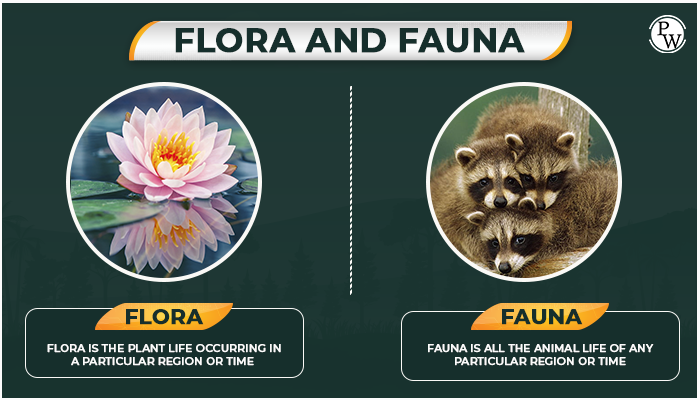
Flora And Fauna
Forests Our Lifeline of Class 7
| Table of Content |
Introduction to Flora and Fauna
An ecosystem is a complex, interconnected network comprising both the elements, i.e., biotic and abiotic. A Biotic component includes all living organisms such as microorganisms, plants, and animals. A abiotic components, on the other hand, include non-living entities that are vital for the survival of life; these include soil, water, climate, etc. Among all biotic elements, flora and fauna are the most fascinating.
Let's take a look at the flora and fauna meaning and their importance.

Flora Meaning
The flora in Latin word means “Goddess of Flowers”. Flora is a collective term for a group of plant life in a particular area. This name represents the entire plant kingdom. Flora is classified and distinguished based on many factors. The best of them is where they grow or are located. Some grow in desert areas or water, some in hilly areas, and some are endemic to a particular geographical location.
Depending on where they grow, they also have modifications. For example, cactus plants are naturally seen in deserts. They have adaptations such as modified leaves or spines to conserve water and protect themselves from predators. Agricultural flora consists of plants cultivated by humans for their use. Horticulture is the practice of decorative flowers and growing ornamental, also known as garden flora.
Fauna Meaning
Fauna represents the animal life native to the region. There are many explanations for the origin of the word. According to Roman mythology, Fauna or "Faunus" is the goddess of fertility. Another source is "Fauns," meaning "Forest Spirits."
The animal kingdom includes various forms of animal life. So the classification of Fauna is much more complicated than the division of flowers. Therefore, for easier classification;
- Birds are categorized under the name Avifauna.
- Fish under the Pisci fauna.
- Microorganisms that include bacteria and viruses are generally considered part of the animal kingdom, known as microfauna.
- All unknown and undiscovered animals are named cryptofauna.
Since immemorial, reports of animals were thought to exist but eluded the scientific community and therefore classified as cryptids or cryptofauna. Most of these reports are normally tall tales, but until recently, a few were documented with actual physical evidence and scientific investigation. One such example is the colossal octopus. This cryptid has been reported to have been sighted since the 17th and 18th centuries and was often cited in sailors' diaries and logbooks.
It wasn't until the 21st century that conclusive evidence was found in the form of a live specimen entangled in a fishing net. It was received and studied by scientists who concluded that it was a new species of octopus. Since then, there has been indisputable confirmation of the existence of giant octopuses.
Earth is most beautiful because of all these forms of life. Other forms of life depend on them for various resources and use them. The conservation of flora and fauna is thus essential for future survival. Biosphere reserves, national parks, zoos, and sanctuaries are a few examples of measures taken by the government to protect flora and fauna. Another example is Project Tiger, launched by the Government of India to save the country's tigers from extinction.
Importance of Flora and Fauna
- Maintains Ecological Balance
Flora and fauna are crucial for human existence. The flora liberates oxygen that is consumed by the fauna for respiratory activities. In turn, Fauna releases carbon dioxide the flora consumes for photosynthesis. Flora and fauna hugely benefit humankind through their medicinal and food offerings.
Animals maintain the equilibrium by predating on different plants and animals to balance their population on earth. Animal droppings are a source of fertilizer. The dead animals decay and act as supplement minerals for other animals.
- Aesthetic Value
Both the Flora and fauna spread across the earth contribute to the aesthetic value of the planet. People visit several biosphere reserves, national parks, zoos, forests, botanical gardens, etc., to enjoy landmarks' beauty. So this explains the significance of flora and fauna in our day-to-day lives.
- Expansion of Local Economies
Both the Flora and Fauna contribute to the local economies through tourism. Flora and fauna of Amazon forests attract tourists and scientists, which contributes about 50 million dollars to the Brazilian economy. Caribbean, Indonesia, and Panama are other tourist locations that attract millions of people due to their widespread flora and fauna.
Flora and Fauna of India
In India, Flora and fauna are diverse, with various plants and animal varieties. The famous fauna of India includes 500 varieties of mammals, 30.000 types of insects, 2000 species of birds, and several varieties of fish, amphibians, and reptiles. Elephants, Royal Bengal Tiger, rhinos, bison, and lions are some common fauna found in the country. India also contains a variety of flora: temperate forests, Alpines, deciduous forests, oaks, rhododendrons, pine, evergreen forests, spruce, deodar, laurels, maples, bamboos, and tall grasses.
Frequently Asked Question (FAQs)
Q1. How are flora and Fauna useful to the environment?
Ans. Flora and Fauna are essential for human life. The flora liberates oxygen that the Fauna consumes for respiratory activities. In comparison, Fauna releases carbon dioxide consumed by the flora for photosynthesis. Flora and Fauna hugely benefit humankind through their medicinal and food offerings.
Q2. What are the factors influencing the variety of flora and Fauna?
Ans. The important elements are temperature, rainfall, soil, altitude, and geographical structure.
Q3. Where did flora and Fauna come from?
Ans. Flora and Fauna are words originating from Latin. Flora in Latin means the goddess of the flower.
Q4. What type of resource is flora?
Ans. Natural resource
Q5. Are bacteria flora or Fauna?
Ans. Flora is the scientific word for a group of plant or bacteria life, typically particular to a specific area. It is often contrasted with the word "fauna," which describes the animal life of the same area.





